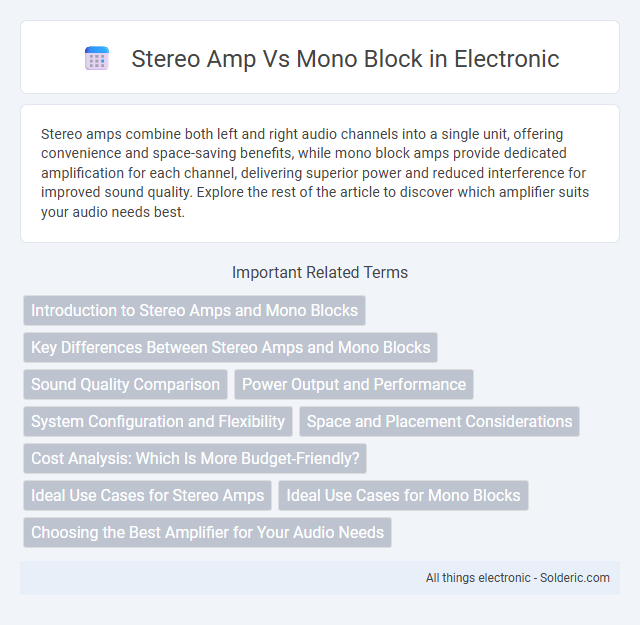Stereo amps combine both left and right audio channels into a single unit, offering convenience and space-saving benefits, while mono block amps provide dedicated amplification for each channel, delivering superior power and reduced interference for improved sound quality. Explore the rest of the article to discover which amplifier suits your audio needs best.
Comparison Table
| Feature | Stereo Amplifier | Mono Block Amplifier |
|---|---|---|
| Channels | Two channels (left and right) | Single channel per unit |
| Power Output | Moderate power shared across two channels | Higher power per channel, dedicated output |
| Sound Quality | Good stereo separation, suitable for most setups | Superior clarity and minimized crosstalk |
| Heat Management | Heat shared across components, less efficient | Better heat dissipation due to separate units |
| Flexibility | Compact, simpler installation | Modular, allows system expansion |
| Cost | Generally more affordable | Usually higher price due to separate units |
| Use Case | Ideal for casual listeners and space-limited setups | Preferred by audiophiles and professional systems |
Introduction to Stereo Amps and Mono Blocks
Stereo amps combine two audio channels into a single unit, delivering left and right sound outputs for a cohesive listening experience. Mono block amplifiers function as individual amps dedicated to powering a single channel, which can enhance sound clarity and reduce interference. Choosing between stereo amps and mono blocks depends on your audio system's design, space, and performance requirements.
Key Differences Between Stereo Amps and Mono Blocks
Stereo amps combine two channels in a single unit, offering a compact design that delivers synchronized audio for left and right speakers, while mono blocks provide dedicated amplification per channel, resulting in improved power delivery and reduced crosstalk. Mono block amplifiers are preferred in high-fidelity audio systems due to superior channel separation and enhanced sound clarity. Stereo amps are cost-effective and space-saving, making them suitable for standard home audio setups, whereas mono blocks excel in audiophile and high-performance applications.
Sound Quality Comparison
Stereo amplifiers combine both left and right audio channels in a single unit, often resulting in slight crosstalk that can reduce sound clarity and separation. Mono block amplifiers dedicate an individual amp to each channel, minimizing interference and delivering superior channel separation, improved dynamic range, and deeper bass response. Audiophiles frequently prefer mono blocks for their enhanced precision and cleaner soundstage, especially in high-fidelity audio setups.
Power Output and Performance
Mono block amplifiers deliver higher power output per channel, minimizing crosstalk and distortion for superior sound clarity and dynamic range. Stereo amps combine both channels into a single unit, providing convenience and space-saving but often sacrificing maximum output and channel separation. Audiophiles seeking peak performance and precise audio control typically prefer mono block amps for enhanced power delivery and improved sonic fidelity.
System Configuration and Flexibility
Stereo amplifiers integrate both left and right channels into a single unit, simplifying system setup and saving space, ideal for straightforward audio configurations. Mono block amplifiers, offering individual amplification channels for each speaker, provide greater flexibility in system customization and can improve sound isolation and power distribution. Choosing between them depends on desired system complexity, expansion possibilities, and specific audio performance goals.
Space and Placement Considerations
Mono block amplifiers require more space as they consist of separate units for each channel, ideal for flexible placement and improved cooling. Stereo amplifiers combine both channels into a single chassis, saving space and simplifying setup but limiting placement options. Choosing between them depends on available room, desired sound separation, and installation flexibility.
Cost Analysis: Which Is More Budget-Friendly?
Stereo amplifiers typically cost less than mono block amplifiers since they combine two channels into a single unit, reducing manufacturing and material expenses. Mono block amplifiers, designed for one channel each, often require purchasing multiple units to achieve the same stereo output, increasing the overall cost. Budget-conscious consumers tend to prefer stereo amps for their cost-efficiency and simpler installation.
Ideal Use Cases for Stereo Amps
Stereo amplifiers excel in environments where space efficiency and simplicity are essential, making them ideal for most home audio systems and smaller setups. They deliver balanced, coherent sound across two channels, providing a seamless listening experience for stereo music and movies in a single unit. Your choice benefits from straightforward installation and maintenance, perfect for casual listeners and those seeking quality audio without complex configurations.
Ideal Use Cases for Mono Blocks
Mono block amplifiers excel in high-performance home audio systems and professional sound setups where channel separation and power output are critical. They are ideal for driving large speakers or subwoofers, ensuring minimal interference and distortion by isolating each audio channel. Audiophiles and home theater enthusiasts rely on mono blocks to achieve superior sound clarity and dynamic range in complex audio environments.
Choosing the Best Amplifier for Your Audio Needs
Stereo amplifiers combine left and right audio channels into a single unit, providing convenience and balanced sound output for your home audio setup. Mono block amplifiers deliver dedicated power to individual channels, resulting in improved channel separation and higher fidelity, ideal for audiophiles seeking precise sound reproduction. Understanding your room size, speaker configuration, and listening preferences will help you select the best amplifier to enhance your audio experience.
stereo amp vs mono block Infographic

 solderic.com
solderic.com